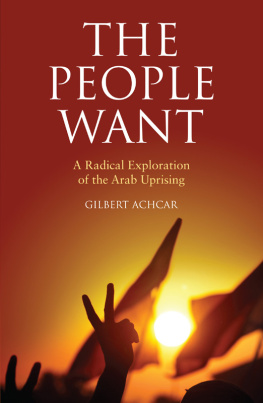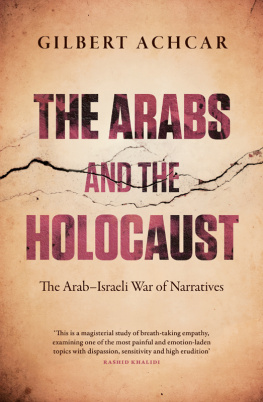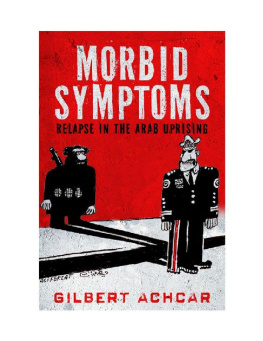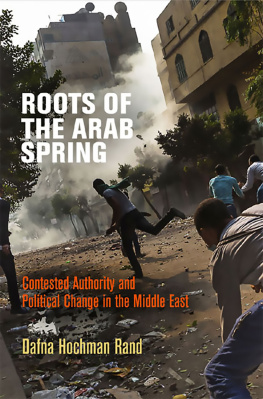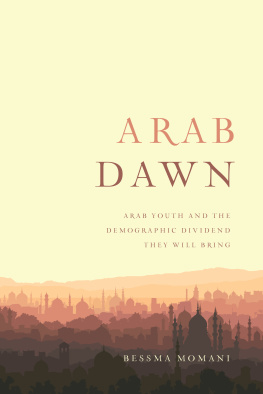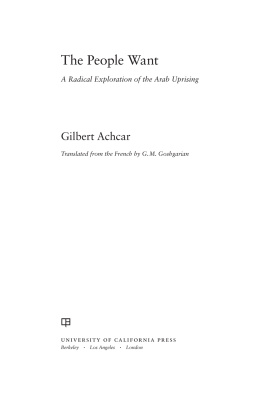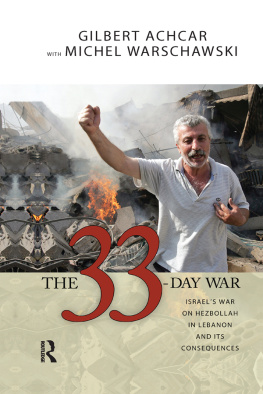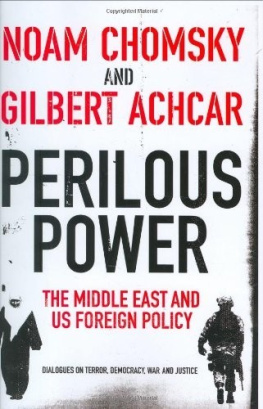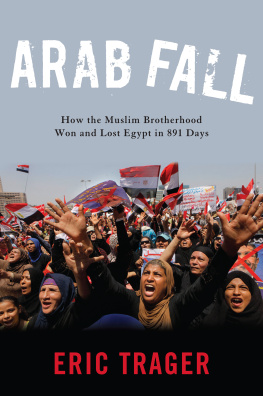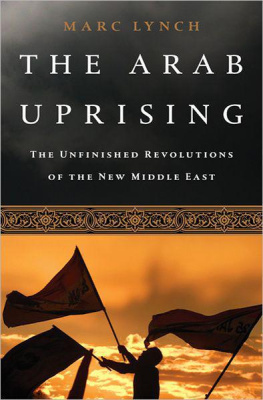Gilbert Achcar, who grew up in Beirut, is Professor at the School of Oriental and African Studies, University of London. His other works include the highly acclaimed The Arabs and the Holocaust: The ArabIsraeli War of Narratives, The Clash of Barbarisms: The Making of the New World Disorder and, with Noam Chomsky, Perilous Power: The Middle East and U.S. Foreign Policy.
ALSO BY GILBERT ACHCAR
The Arabs and the Holocaust:
The ArabIsraeli War of Narratives
Perilous Power:
The Middle East and U.S. Foreign Policy
(with Noam Chomsky)
The 33-Day War:
Israels War on Hezbollah in Lebanon and its Consequences
(with Michel Warschawski)
The Clash of Barbarisms:
The Making of the New World Disorder
The Israeli Dilemma:
A Debate between Two Left Wing Jews:
Letters between Marcel Liebman and Ralph Miliband
(selected with an introduction and epilogue by Gilbert Achcar)
Eastern Cauldron:
Islam, Afghanistan, Palestine, and Iraq in a Marxist Mirror
THE PEOPLE WANT
A Radical Exploration of the Arab Uprising
Gilbert Achcar
Translated from French by G. M. Goshgarian
SAQI
Published 2013 by Saqi Books
Copyright Gilbert Achcar 2013
Translation G. M Goshgarian 2013
ISBN 978-0-86356-899-2
eISBN 978-0-86356-832-9
Gilbert Achcar has asserted his right under the Copyright, Designs and Patents Act, 1988, to be identified as the author of this work.
This book is sold subject to the condition that it shall not, by way of trade or otherwise, be lent, resold, hired out, or otherwise circulated without the publishers prior consent in any form of binding or cover other than that in which it is published and without a similar condition including this condition being imposed on the subsequent purchaser.
First published in Great Britain in 2013 by
Saqi Books
26 Westbourne Grove
London W2 5RH
www.saqibooks.com
A full cip record for this book is available from the British Library.
Printed and bound by Bookwell in Finland
Contents
Figures
Tables
Acknowledgements
This book is the outcome of intensive work that started shortly after the beginning of the revolutionary wave engulfing the Arabic-speaking region. It is based, however, on the course on Problems of Development of the Middle East and North Africa that I have taught at the School of Oriental and African Studies (SOAS, University of London) since the academic year 20078. This means that I owe much to my institution, which offers an ideal environment and one of the richest libraries for the research on the region that is the object of this study. The students who attended my lectures and who will remember them when they read the following pages have contributed with their questions to forming the answers this book provides.
Yet scholarly teaching and research are but two of the sources of this work. My major debt is toward the great number of those whom I met and with whom I had a chance to discuss during my travels in different countries of the region over decades, and most particularly since the beginning of the uprising. I clearly cannot name them all. Four key stages in this experience occurred in 2011, when I was honoured to be invited to take part in the Spring University of ATTAC Morocco in Casablanca, in April; the Socialist Days organised in Cairo after the uprising by the Egyptian Center for Socialist Studies, in May; the meeting of prominent members of the Syrian opposition, many of whom came directly from Syria to the place near Stockholm where it was held, in October; and the festivities celebrating the first anniversary of the beginning of the uprising in Sidi Bouzid, the Tunisian town where it all started, in December. I thank here one more time the organisers of these meetings, as well as the team of the Haus der Kulturen der Welt in Berlin which gave me the opportunity to take part in a gathering of persons involved in cultural activities in the Arab region in January 2012.
I am also grateful to all those who invited me to submit some of this books theses to the critical attention of audiences including people knowledgeable about the region in various academic institutions in particular Henry Laurens at the Collge de France, Robert Wade at the London School of Economics, Rashid Khalidi and Bashir Abu-Manneh at Columbia University in New York, Joel Beinin at Stanford University, Ronit Lentin at Trinity College in Dublin, Haideh Moghissi and Saeed Rahnema at York University in Toronto, Farid al-Alibi at the University of Kairouan, Tunisia, Tullo Vigevani at the Universidade Estadual Paulista (UNESP) in So Paulo, and the Brazilian National Social Science Postgraduate and Research Association (ANPOCS) at its annual convention in Caxambu.
The friends whose names follow have read the manuscript of this book in part or in whole and given me the benefit of their comments in finalising it: Henry Bernstein, Ray Bush, Franck Mermier, Saleh Mosbah, Alfredo Saad-Filho, Fawwaz Traboulsi and Lisa Wedeen. Very acute remarks by Omar El Shafei, who translated this book into Arabic, were most useful. My collaboration for the second time with Geoff Michael Goshgarian, who translated this book into English most elegantly after my previous one, The Arabs and the Holocaust, was equally an opportunity for useful exchanges between us. I beg those whom I failed to mention in these acknowledgements to excuse me. None of the above-mentioned persons can in any way be held responsible for the theses of this book and the errors that it may include.
Preliminary Notes
On the Arab countries and the Middle East and North Africa (MENA)
In the following pages, Arab refers to the member states of the Arab League (with the exception of the Union of the Comoros, Djibouti and Somalia). These countries are called Arab because Arabic is their main language of administration, communication and instruction. Thus Arab and Arabic are, here, geopolitical and linguistic terms (whence also the occasional reference to the Arabic-speaking region); neither is in any sense an ethnic description. Non-Arab groups comprise a significant segment of the populations of these countries, notably the Amazigh in North Africa (Maghreb) and the Kurds in the Middle East (Mashriq). They have taken an active part in the uprisings in the region.
Several international institutions whose studies and statistics are copiously cited in the present book focus on a group of countries they call Middle East and North Africa (MENA or the MENA region). In addition to the countries identified above, MENA includes Iran. When data limited to the Arab states are lacking, data for the MENA region have been used.
All the figures published in this book are original; the sources of the data used in making them are indicated.
On Transliteration of Arabic
The method adopted for the transcription of Arabic words and names in the Latin alphabet is a simplified version of the transliteration system in use in specialised literature; the aim is to make it easier for non-specialists to read the text, while allowing the knowledgeable to recognise the original Arabic. Special characters and diacritical marks have been avoided, except for the inverted apostrophe representing the Arabic letter ayn. The common spellings of the names of the best-known individuals have been retained. Finally, when Arabs have published in European languages, their own transliteration of their names in Latin letters has been respected, as has, in the citations, the transliteration of Arabic names in the form in which it occurs in the original.
Next page
